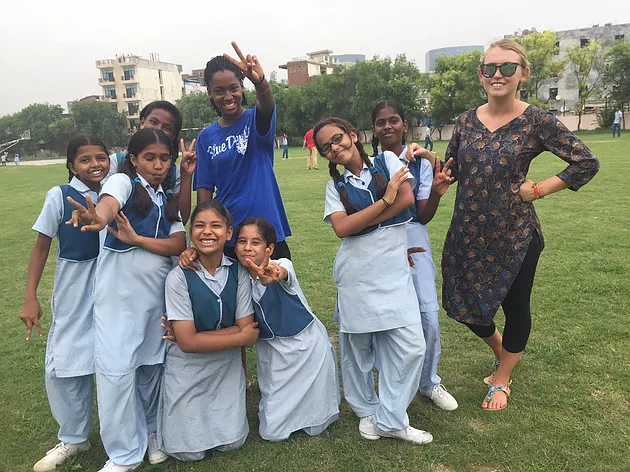
When we first came to India, we immediately noticed the stark contrasts between our country and the one we would be living in for the next three weeks. The car ride to our home base was wild, the weather was moist and dusty, and the clothing was colorful and very conservative. The road was inhabited with cars, rickshaws, tuk-tuks, and a slew of animals. Food vendors lined the street, unfortunately alongside begging families. Buildings lined the sky — some magnificent structures, and some slowly crumbling.
Going into our second week of teaching, we started to realize the country that seemed so foreign to us upon arrival, now seemed familiar. We were beginning to grasp our bearings and felt confident navigating our way through the local markets. Realizing this, we decided we would teach our English classes the structure of Venn-diagrams. We educated the children on the process of comparing and contrasting differing subjects, so as to reach conclusions on how certain things may be alike, or dissimilar. We concluded the lesson by asking our classes to compare and contrast both of our countries.
As our week came to a close and we sat in our Friday reflection session, our program director, Bela, asked us to, coincidentally, compare and contrast the United States and India, politically, economically, and socially.
First we discussed the politics of our two countries.
In India, the Prime Minister makes up the executive branch, while their President acts as more of a figurehead. In the United States, President Barack Obama currently sits at the head of the executive branch.
For our two countries, the celebration of Independence Day holds great importance. Each country designates a holiday where people spend time with their families eating, drinking, and enjoying tradition.
India regrettably faces a serious pollution and waste problems. Like the United States, the Indian government is taking great initiative to clean up the country and to lessen the impact of corporate pollution. This government initiative interestingly begins with average citizens. Here, it is customary for citizens to throw their trash on the streets, on the ground, in the parks, etc. If this daily habit could be eradicated completely, India would see a drastic change in the cleanliness of their cities; this will take generations worth of initiative, but the effort has already begun due to their current Prime Minister.
“Yet, what began as a journey of noticing differences has turned into an adventure of discovering similarities. Our cultures may be different, our clothing may be different, and our driving may be entirely different, but at the end of the day we are all people…”
We then moved onto the differing economics of our country.
To the world, India is known as a third-world country, and the United States is known as a first-world country, and this is based upon economic standards. It is important to note, that India only considers itself a developing country from an economic standpoint. They reject the terminology of “developing” from a social and political standpoint, due to their culture’s rich history. When they look to the United States, they believe we are a developing country as well, but from a social standpoint, for we are adapting and changing so rapidly in our social climate.
Vidya, the school we are working in, held an assembly to celebrate India’s Independence Day. The founder of Vidya, in her speech to the school, reminded us that in India economic freedom is defined by the freedom from hunger and malnutrition. In the United States, we nowadays believe economic freedom is the freedom to do with your earnings as you wish.
We concluded by discussing our social differences.
To the world, we as Americans make up an individualistic society. We work to better our own lives, and we work to see ourselves succeed. India is a culture of collectivism, where the family is the central unit of ones life; nothing is more important than family.
For us Americans, timing is everything. Being late to an interview is unacceptable, and keeping a friend waiting is considered rude. In India, it could not be more opposite. Their use of the clock as a measuring tool is lax. They worry that an activity will not be completed, but they do not worry when you begin the activity, or when it is finished.
For both countries, dance is a medium to tell a story. In India, these stories are a tool to educate the current generations on a rich history of tradition. In the United States dance, while still telling story, has become more of a unit of emotional expression.
We are Americans living in India for three weeks. We come from a completely different place than the place we are currently taking up residence. Yet, what began as a journey of noticing differences has turned into an adventure of discovering similarities. Our cultures may be different, our clothing may be different, and our driving may be entirely different, but at the end of the day we are all people, looking for happiness, fighting for safety, and seeking out love.
